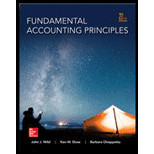
Concept explainers
Perpetual Inventory system is an inventory system in which a organization continuously update its inventory records. All the movements related to inventory are updated continuously such as purchase quantity, sales quantity, and purchase or sales return etc.
There are several methods of calculating the value of inventory in closing stock which are as below:
FIFO method (First In First Out) is the most using method of
LIFO method (Last In First Out) is the method in which the quantity which purchase in last before sale transaction will be sold first. In closing inventory the quantity will be counted from the beginning inventory and purchase thereafter.
Weighted Average method is the most commonly used method after FIFO method. In weighted average the quantity of all purchases and beginning inventory is clubbed and then a weighted average rate is calculated and closing inventory is valued at weighted average rate.
Specific Identification method is the method in which the quantity is specifically identified that from which lot or purchases the closing stock is available and the closing inventory is valued by taking rates and quantities of that specific lot(s) from which closing inventory is available.
Under perpetual method a job card is prepared for each lot and calculation is done for each lot/transactions accordingly.
Requirement-1:
To Calculate:
In the given question we have to calculate the following details under perpetual inventory system:
- Cost of goods and quantity available for sale
Requirement-2:
To calculate:
We have to calculate units in closing stock under perpetual inventory system.
Requirement-3:
To calculate:
We have to calculate cost of closing inventory using FIFO, LIFO, Weighted Average and Specific Identification method.
Requirement-4:
To calculate:
We have to calculate gross profit under FIFO, LIFO, and Weighted Average and Specific Identification method under perpetual inventory system.
Requirement-5:
To determine:
We have to determine that manager will prefer valuation method as it earns on percentage of gross profit.
Want to see the full answer?
Check out a sample textbook solution
Chapter 6 Solutions
Fundamental Accounting Principles -Hardcover
- Please help me solve this general accounting question using the right accounting principles.arrow_forwardNeed answer! What type of account is 'Unearned Revenue'?A) AssetB) LiabilityC) EquityD) Revenuearrow_forwardPlease provide the solution to this general accounting question using proper accounting principles.arrow_forward
- Financial accountingarrow_forwardWhat type of account is 'Unearned Revenue'?A) AssetB) LiabilityC) EquityD) Revenue help!!arrow_forwardIn early January 2024, Swifty Corporation applied for a trade name, incurring legal costs of $17,400 in January 2025, Swifty incurred $7,200 of legal fees in a successful defense of its trade name Compute 2024 amortization 12/31/24 book value 2025 amortization, and 12/31/25 trade name over 30 years (Round anwers to Odecimal places, eg 5.125) 2024 amortization 12/31/24 book value 2025 amortization 12/31/23 book value eTextbook and Media Compute the 2025 amortization and the 12/31/25 book value assuming that at the beginn of 2025 Sty determines that the trade name will provide no future benefits beyond December 31, 2028 2025 amortization 12/31/25 book value eTextbook and Media Ignoring the responses the 2026 amortization and the 12/31/24 book vali •Compute the 2423 amortization and the 12/23/2ɔ book varu, assuming that the trade name will provide no future benefits beyond December 31, 2028 2025 amortization 12/31/25 book value eTextbook and Media mines that Ignoring the response for…arrow_forward
- Can you explain the process for solving this financial accounting problem using valid standards?arrow_forwardI am trying to find the accurate solution to this financial accounting problem with appropriate explanations.arrow_forwardWhat type of account is 'Unearned Revenue'?A) AssetB) LiabilityC) EquityD) Revenueexplainarrow_forward

 AccountingAccountingISBN:9781337272094Author:WARREN, Carl S., Reeve, James M., Duchac, Jonathan E.Publisher:Cengage Learning,
AccountingAccountingISBN:9781337272094Author:WARREN, Carl S., Reeve, James M., Duchac, Jonathan E.Publisher:Cengage Learning, Accounting Information SystemsAccountingISBN:9781337619202Author:Hall, James A.Publisher:Cengage Learning,
Accounting Information SystemsAccountingISBN:9781337619202Author:Hall, James A.Publisher:Cengage Learning, Horngren's Cost Accounting: A Managerial Emphasis...AccountingISBN:9780134475585Author:Srikant M. Datar, Madhav V. RajanPublisher:PEARSON
Horngren's Cost Accounting: A Managerial Emphasis...AccountingISBN:9780134475585Author:Srikant M. Datar, Madhav V. RajanPublisher:PEARSON Intermediate AccountingAccountingISBN:9781259722660Author:J. David Spiceland, Mark W. Nelson, Wayne M ThomasPublisher:McGraw-Hill Education
Intermediate AccountingAccountingISBN:9781259722660Author:J. David Spiceland, Mark W. Nelson, Wayne M ThomasPublisher:McGraw-Hill Education Financial and Managerial AccountingAccountingISBN:9781259726705Author:John J Wild, Ken W. Shaw, Barbara Chiappetta Fundamental Accounting PrinciplesPublisher:McGraw-Hill Education
Financial and Managerial AccountingAccountingISBN:9781259726705Author:John J Wild, Ken W. Shaw, Barbara Chiappetta Fundamental Accounting PrinciplesPublisher:McGraw-Hill Education





